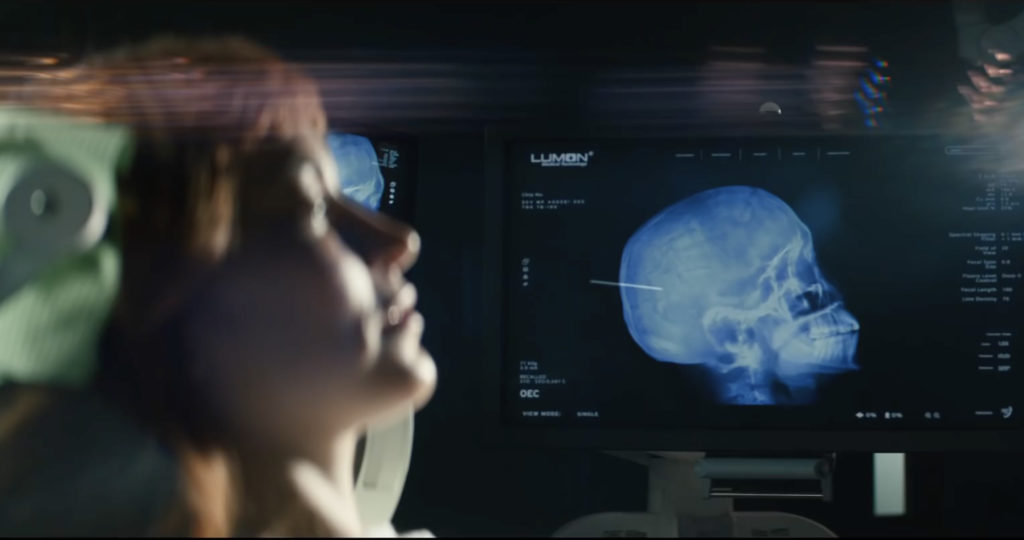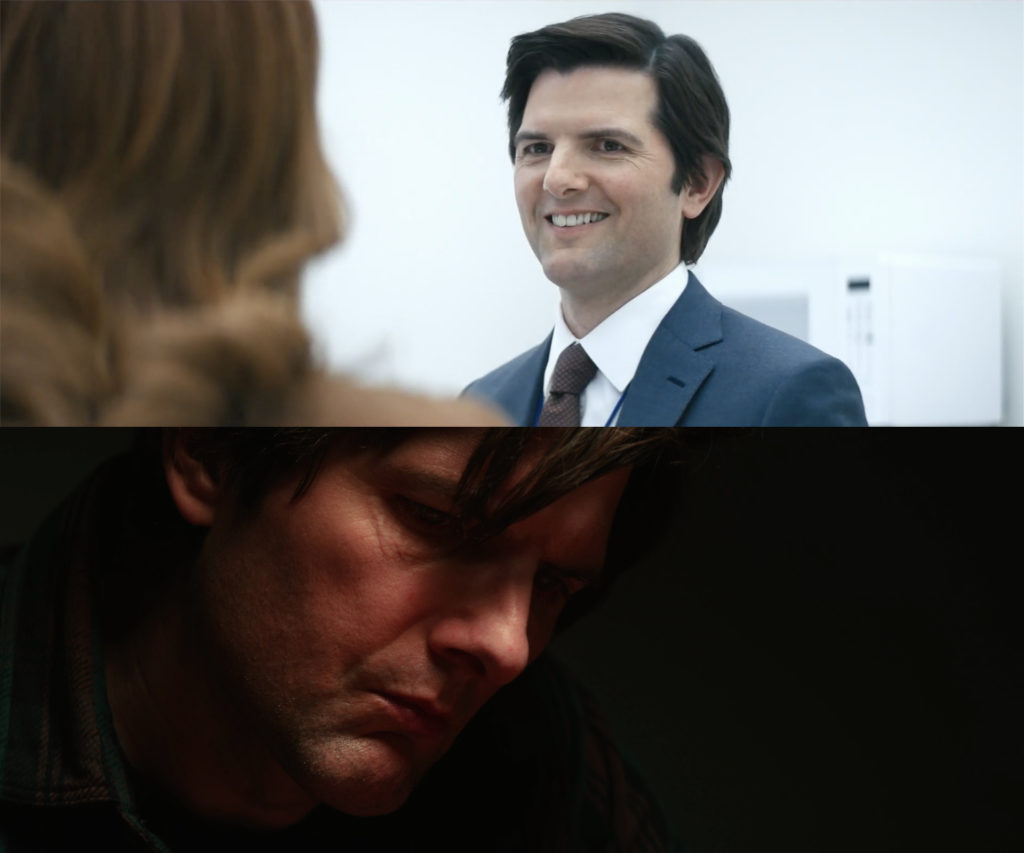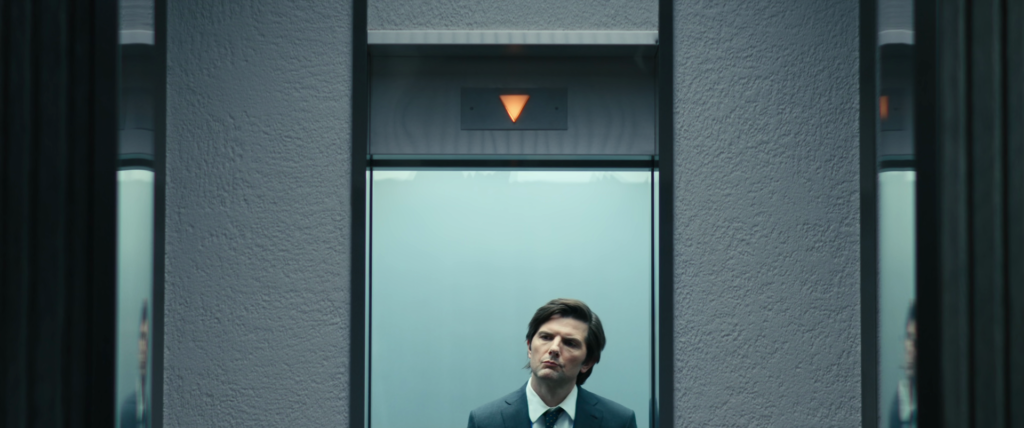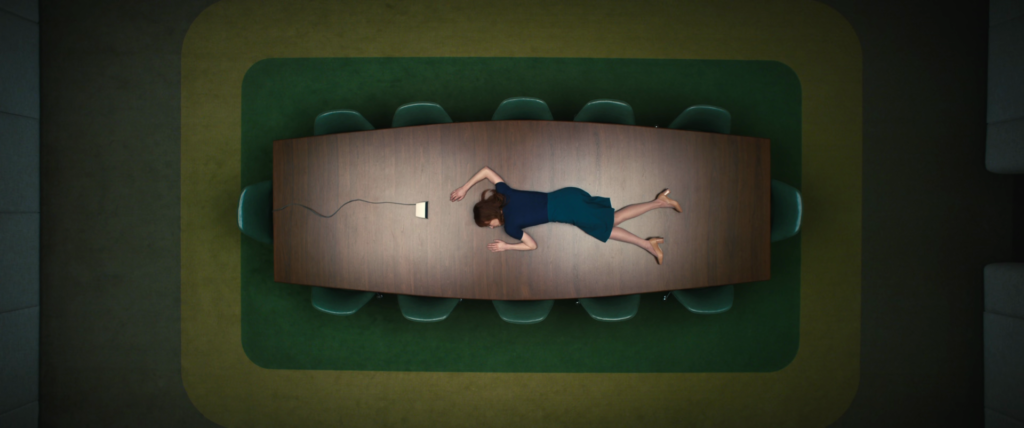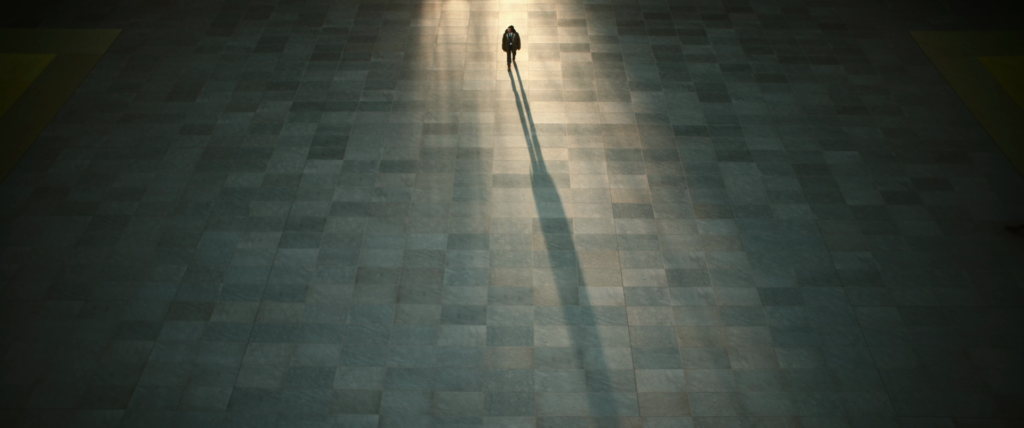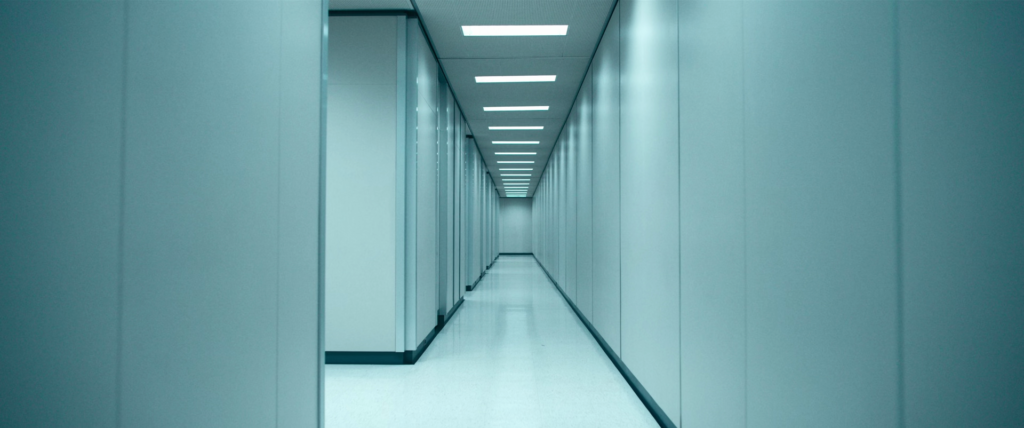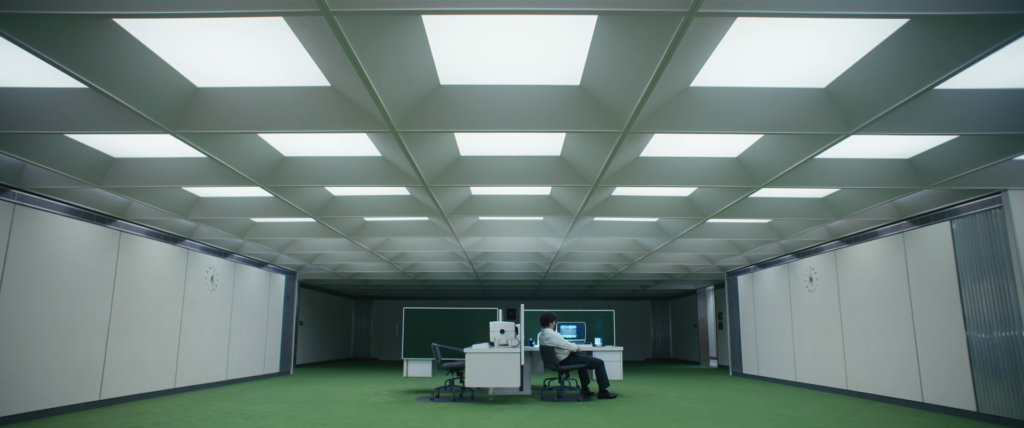Severance Talk
When we read about Metamodernism we’re struck by dichotomies. There’s an oscillation between “a modern enthusiasm and a postmodern irony, between hope and melancholy, totality and fragmentation.”[1]Vermeulen, T. and van den Akker, R., 2010. “Notes on Metamodernism”. Journal of Aesthetics & Culture, 2(1), DOI: 10.3402/jac.v2i0.5677
We can see that there is a divide or a separation between two states. In the 21st century, we see these separate eras that have moulded our world over the past 150 years as merely parts of what it means to Be Human and we are trying to ‘integrate’ the two and exist in the porous border between them in a Both/Neither way. And that isn’t always easy.

Teaser trailer.
The severance chip spatially divides your memories. Memories from your experiences inside Lumon can ONLY be accessed when you are in Lumon and cannot be accessed from elsewhere. And experiences from outside of that space, cannot be accessed when you are in there.
This effectively produces two versions of you. You’re split. This is the Digital/Real World analogy.
The one who is In work, In Lumon Corporation is the Innie… The one who is Out of work is the Outie… Or the Digital self and the Real self. They are two different people with two different lives, different experiences, different friends and different personalities…
The Innies work for non-monetary rewards – finger traps or caricatures or waffle parties in Severance; our Digital selves work for likes and followers and upvotes. Outies in Severance receive the paycheck and the subsidised housing from the work the Innies do. Our Real Selves benefit from the dopamine hits. The Innies’ work affects the Outies’ lives, just as our Digital Self’s ‘work’, can affect our Real Self…
The only important way the Outie affects the Innie’s life is by stepping into the elevator to the Severed Floor at work every morning. The only way our Digital Self exists is if our Real Selves logs them on.
Innies ONLY exist on the Severed Floor of Lumon’s office. If the Outie quits their job, the Innie basically dies. Our Digital Selves, only exist online. If we never log onto our Facebook account again, that version of you ends.
In 2014, Mark Fisher in Ghosts of My Life [2]Fisher, M. (2014) Ghosts of My Life: Writings on Depression, Hauntology and Lost Futures. Winchester, UK: Zero books. wrote about the idea of a pining for ‘lost futures’- this is the idea that during the Modern era we had a collective vision of the future, but as postmodernity removed the arrow of time by always looking back and reproducing, remodelling and reinterpreting the past, we have lost our collective future. We are temporally dislocated or disconnected or separated from Time… A chronological alienation. It is the missing connection with Time that deeply pervades our culture.
Severance has a constantly shifting representation of time. The production and costume design have used influences from the 1930s on… and we never quite settle on one particular era… …we are neither stuck in a past… … nor stuck in a future… It feels contemporary- the dialogue, the humour, the characters’ personalities all feel ‘now’ – but visually it could also be set in a retrofuturistic 1980s.
This operates in a similar way to ‘crackle’ on a record. Again Mark Fisher, in Ghosts of My Life, said about crackle in songs, “Crackle makes us aware that we are listening to a time that is out of joint; it won’t allow us to fall into the illusion of presence.” It’s now, but not now. Then, but not then. The design in Severance is visual crackle.
The representation of space in the series also mirrors our strange relationship with our territory… When we are in the grand, brutalist space of the Perpetuity Wing of Lumon’s severed floor, we feel the enclosure of a Disciplinary space [3]Foucault, M. (1995) Discipline and Punish: The Birth of the Prison. 2nd Vintage Books ed. New York: Vintage Books.. It’s a high ceiling, but it’s still a ceiling and we are underground a couple stories, at least. That isn’t daylight coming in from above. We never see daylight there.
In the large Macro Data Refinement office, there are four desks lumped together with partitions between them. Even in the office, the four workers are both bound together and kept apart… all encouraged to observe one another and keep each other behaving by the rules… much like reporting people online for behaviour we individually don’t like in our online communities.
Lumon also operates as a Controlled space [4]Deleuze, G. (1992) ‘Postscript on the Societies of Control’, October, 59(Winter, 1992), pp. 3–7. Available at: https://www.jstor.org/stable/778828. The Innies are seemingly free to walk in the maze-like hallways, but can only access spaces that are opened by their key cards. They are under constant and total surveillance both on cameras… and via the extensive security system that knows the exact location of everyone on the severed floor… This mirrors our Digital Self’s experience online where we need passwords and codes to access various spaces and we leave a trail of data that knows everything about us.

Another video: Severance starts with the first moment Helly R arrives on the severed floor. She doesn’t like it, she wants to leave, but she needs the permission of her Outie in order to quit her job. She threatens to self-harm and receives a message from her Outie…
Eric Fromm [5]Fromm, E. (2013) On Being Human. New York: Open Road Integrated Media, Inc.
said: When we see in person someone we only know from television, we say “He looks just like he does on television!” Reality is the TV picture; and the correctness of our perception of how that person really looks is measured against that reality… Our reality lies on the screen. Helly’s Innie is a shadow of this reality, she isn’t “real”.
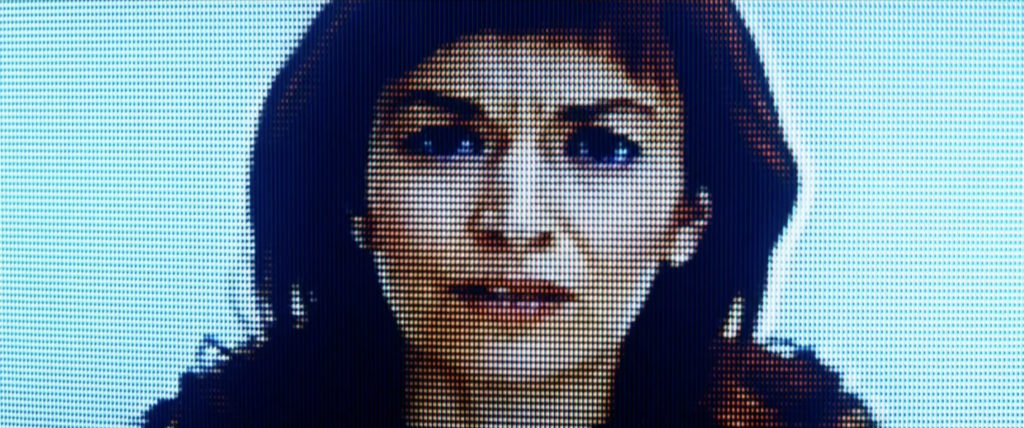
Alienation is a Modernist idea. It pre-supposes the presence of an Ideal You that exists outside of society and, if only there wasn’t all of this messy real world stuff, you would be your Ideal Self. Karl Marx defined subjective alienation as the separation of the worker from the product of her labour[6]Karl Marx. Economic and Philosophic Manuscripts of 1844. Trans. Martin Milligan edited D.J. Struik. London: Lawrence & Wishart
. The worker would put their life into making an object, so that the life no longer belongs to the worker, but to the object…
So this working life is external to her, existing independently to her… A Work Life, if you will. Marx said the only time one was Human or Real was when they weren’t working, when they were at home. So… a Home Life. We were divided between two worlds…
By the end of the 20th century however, this wasn’t conceptually an issue for us. We had Business Hours and Work Friends… and Office Attire…
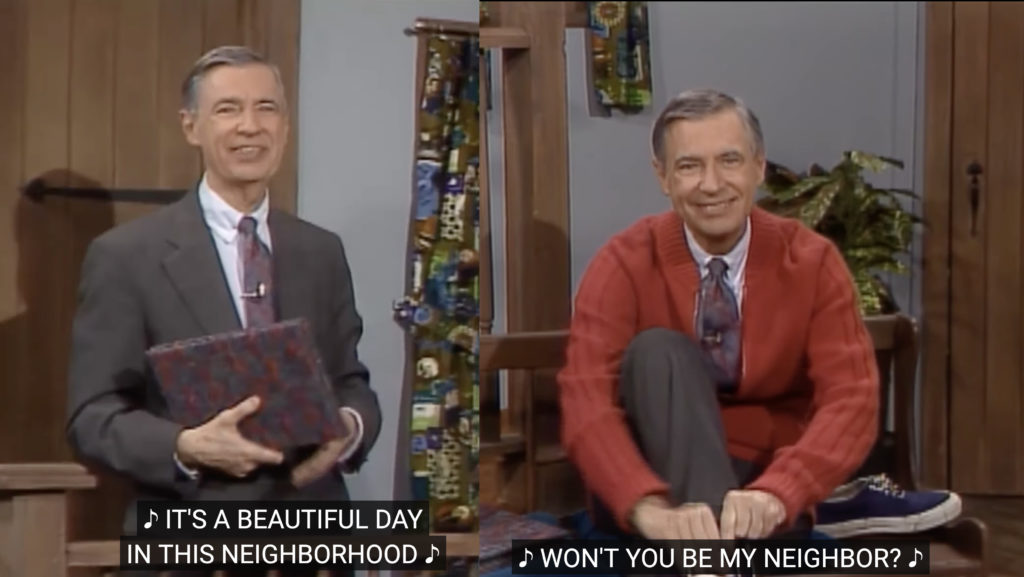
We were no longer thinking of ourselves as “separated from our true nature”.
Instead, as Fredric Jameson said[7]Jameson, F. (1991) Postmodernism or, The Cultural Logic of Late Capitalism. Durham: Duke University Press., within Postmodernism ‘the alienation of the subject is displaced by fragmentation of the subject’. This splintering of the Human into discrete, affectively and experientially bounded labels – the refreshed Coca Cola drinker, the happy office worker, the rebellious music fan– turned us into a series of identities describing our various roles, ideas and preferences.
So within postmodernism we can’t be alienated because there isn’t an Us to be alienated and there isn’t an Ideal Us to be alienated from. And it’s not just within postmodernism. In psychology and neuroscience we started to understand that there is no Innate You that exists outside of the social influences, conditioning, experiences and memories that have moulded you into The You You Are right now.
So we KNOW there is no Real Me… But we are increasingly Feeling like there is a Real Me, a Better Me, a Me I should be… Right now in the West, huge numbers of people from all walks of life and different political persuasions feel like feel like they are being prevented from ‘being Whole’, they feel that there is a different, perfect life they ‘should’ be living, feel like they have an ‘authentic self’.
And online or in games, we are able to live as a different Us and we Feel like it is real… and more and more of us think we can be that True, Authentic, Heroic version of our Digital Self in the Real World, too… We are Real and Digital, Real and Fantasy, Real and Timeless/Spaceless. The Real World Us is fragmented and the Digital Us believes the perfection or the Utopia that a non-physical space promises will somehow come into fruition in the real world. The Fragmented Self that is split between two worlds is what’s at the root of Metamodern alienation…
And so we have a removal from Time but with a hope of a perfect future, a sense of confinement, scrutiny and control in a space that isn’t easily navigated and a separation of our fragmented selves, divided by a screen… This is our 21st century condition… and yet despite everything that has attempted to separate the Innies in Severance from a grounding in The Real, they discover Connection, Love, Responsibility and a sense of Sacrifice for the greater good… and most importantly they find Compassion for their fellow human beings…
The 21st century will see us grappling with naming, defining and understanding the border between the real and the digital. If we define that border from only one perspective, we see only one of those worlds and we feel the division. The trick is to understand that border in a way that acknowledges the two worlds so we can hopefully see ourselves fully as people not merely parts of people.
References
| ↑1 | Vermeulen, T. and van den Akker, R., 2010. “Notes on Metamodernism”. Journal of Aesthetics & Culture, 2(1), DOI: 10.3402/jac.v2i0.5677 |
|---|---|
| ↑2 | Fisher, M. (2014) Ghosts of My Life: Writings on Depression, Hauntology and Lost Futures. Winchester, UK: Zero books. |
| ↑3 | Foucault, M. (1995) Discipline and Punish: The Birth of the Prison. 2nd Vintage Books ed. New York: Vintage Books. |
| ↑4 | Deleuze, G. (1992) ‘Postscript on the Societies of Control’, October, 59(Winter, 1992), pp. 3–7. Available at: https://www.jstor.org/stable/778828 |
| ↑5 | Fromm, E. (2013) On Being Human. New York: Open Road Integrated Media, Inc. |
| ↑6 | Karl Marx. Economic and Philosophic Manuscripts of 1844. Trans. Martin Milligan edited D.J. Struik. London: Lawrence & Wishart |
| ↑7 | Jameson, F. (1991) Postmodernism or, The Cultural Logic of Late Capitalism. Durham: Duke University Press. |
